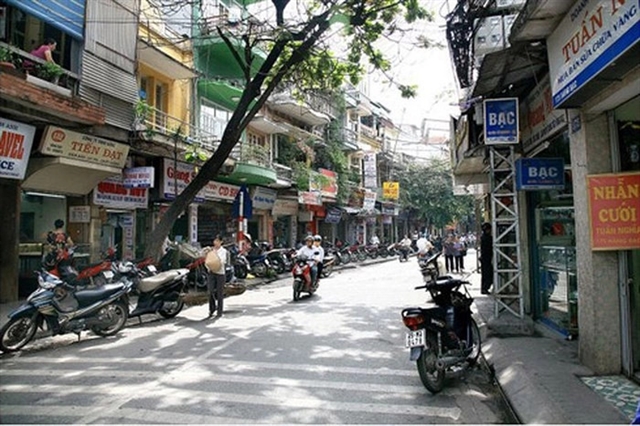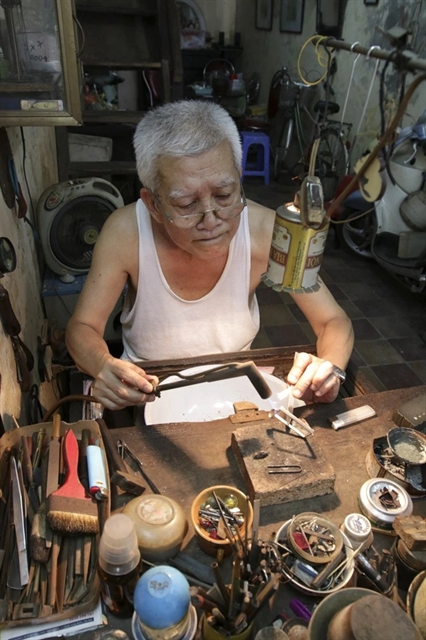
|
| A shop that makes traditional moon cake moulds and handmade stamps on Hàng Quạt Street. — Photo laodong.vn |
By Thanh Nga
The Old Quarter has been a hub for handicraft and trade activities for the people of Hà Nội throughout history. Consequently, preserving and developing traditional occupations within the Old Quarter is regarded as a crucial task in the present day.
Hoàn Kiếm, located in the heart of the ancient Thăng Long Citadel and today’s Hà Nội Capital, is a district with a rich history dating back thousands of years. It serves as a gathering place for talented individuals from all over the country, leaving their mark on the streets with the names associated with their respective professions.
In the memories of Hà Nội residents, the Old Quarter is not just an “urban cultural village,” but also a place where handicraft activities and trade flourish, forming distinctive craft streets. In the past, there were numerous “Hàng” streets named after the specific handicraft items produced and traded by households.
For example, Hàng Bông Street was known for selling cotton, cotton blankets, and mattresses produced by villagers from Thanh Oai. Hàng Lược Street specialised in wooden combs and horn combs, products of the people from Thụy Ứng and Thường Tín Villages. Hàng Bạc Street was the hub for silver carving, with artisans from Đồng Xâm (Thái Bình Province), Châu Khê (Hưng Yên Province), and Định Công (Thanh Trì, Hà Nội) practising and trading their craft. Hàng Đào Street was renowned for silk weaving, with most residents hailing from Đan Loan Village, Bình Giang District, Hải Dương Province.
Challenges
Traditional handicrafts across the country are currently facing several challenges, including competition from industrial products, low-cost imported goods, a shortage of skilled artisans in craft villages, issues related to raw materials, high prices, and limited marketing and consumption markets. Craft streets and traditional crafts in Hà Nội’s Old Quarter are not exempt from these challenges.
According to Đoàn Quang Cường, deputy head of the Economic Department of Hoàn Kiếm District, the process of urbanisation has transformed the space, landscape, and architecture, resulting in the narrowing of activities on many streets. The handicraft streets and shops in the Old Quarter are progressively diminishing.
Only a few streets in the Old Quarter still retain traditional crafts, while the rest have nearly disappeared. Bát Sứ Street, formerly known as Hàng Chén Street, was once known for trading ceramics and porcelain products. However, it has now shifted its focus to the hotel and restaurant industry.
Hàng Bồ Street, previously specialising in manufacturing and trading bamboo products, now has around 35 households engaged in the needle, thread, button, and garment accessory business.
While Hàng Mã Street continues to trade votive products and items for the Mid-Autumn Festival, the production activities associated with it have ceased. Similarly, the number of jewellery stores, traditional medicine shops, and silk stores has significantly decreased on Hàng Bạc Street, Lãn Ông Street, and Hàng Gai Street.

|
| A shop that makes traditional moon cake moulds and handmade stamps on Hàng Quạt Street. — Photo laodong.vn |
Nguyễn Mạnh Linh, chairman of the People’s Committee of Hàng Gai Ward, explains: “There are multiple reasons contributing to this situation, primarily due to crowded land and changing consumer demands. Additionally, traditional products that were once exclusive to Hàng Gai Ward have now been traded in numerous other locations.”
Connection and support
Preserving the tangible and intangible cultural values associated with Hà Nội’s Old Quarter, a national historical site, is of utmost importance. Maintaining and developing traditional occupations within the Old Quarter is both a task and an opportunity for the residents and relevant agencies.
For many years, Hoàn Kiếm District has recognised the preservation and promotion of heritage values, including traditional crafts, as an important short-term and long-term objective. It serves as an advantage for the district’s sustainable socio-economic development.
To safeguard the values of traditional craft heritage, one of Hoàn Kiếm District’s important resources, the district has focused on solutions to exploit and promote the potential and strengths of the craft streets. These solutions include raising awareness through propaganda, promotions, and introducing the values of traditional crafts; diversifying tour offerings by connecting historical and cultural relics and craft streets within the district to city tours; establishing exhibition venues for handicraft products, souvenirs, and gifts from craft villages and Hà Nội craft streets.
However, there are still numerous difficulties and challenges in preserving and promoting the value of traditional crafts in the Old Quarter.

|
| Nguyễn Chí Thành, a jeweller on Hàng Bạc Street. — Photo dantri.com.vn |
During the seminar “Hà Nội Traditional Crafts – Creativity for Development” organised by Hoàn Kiếm District People’s Committee, several speakers put forward specific proposals. These proposals focused on solutions such as conducting comprehensive surveys of traditional craft streets within the district to determine which streets and traditional trades can be sustained, promoted, and developed. Detailed and specific planning for unique traditional occupations is also necessary.
Furthermore, there is a need for collaboration between wards in the district and among traditional craft streets in the Old Quarter to create a series of activities that attract tourists. Additionally, investment policies should be implemented to train and develop human resources and harness the talents of artisans.
According to Phạm Tuấn Long, chairman of Hoàn Kiếm District People’s Committee: “Traditional handicrafts require the collaboration and support of designers, investors, and businessmen to ensure that each traditional handicraft product carries the representative heritage message of its respective locality and region. Creating new products based on traditional core values is crucial for handmade products to become popular souvenirs for tourists.”
“Therefore, fundamental solutions include product introduction, trade promotion, sourcing appropriate raw materials, product design, packaging, and labels that cater to the tastes of domestic and international consumers,” Long added. VNS
- Reduce Hair Loss with PURA D’OR Gold Label Shampoo
- Castor Oil Has Made a “Huge” Difference With Hair and Brow Growth
- Excessive hair loss in men: Signs of illness that cannot be subjective
- Dịch Vụ SEO Website ở Los Angeles, CA: đưa trang web doanh nghiệp bạn lên top Google
- Nails Salon Sierra Madre
 VnExpress News The News Gateway of Vietnam
VnExpress News The News Gateway of Vietnam





